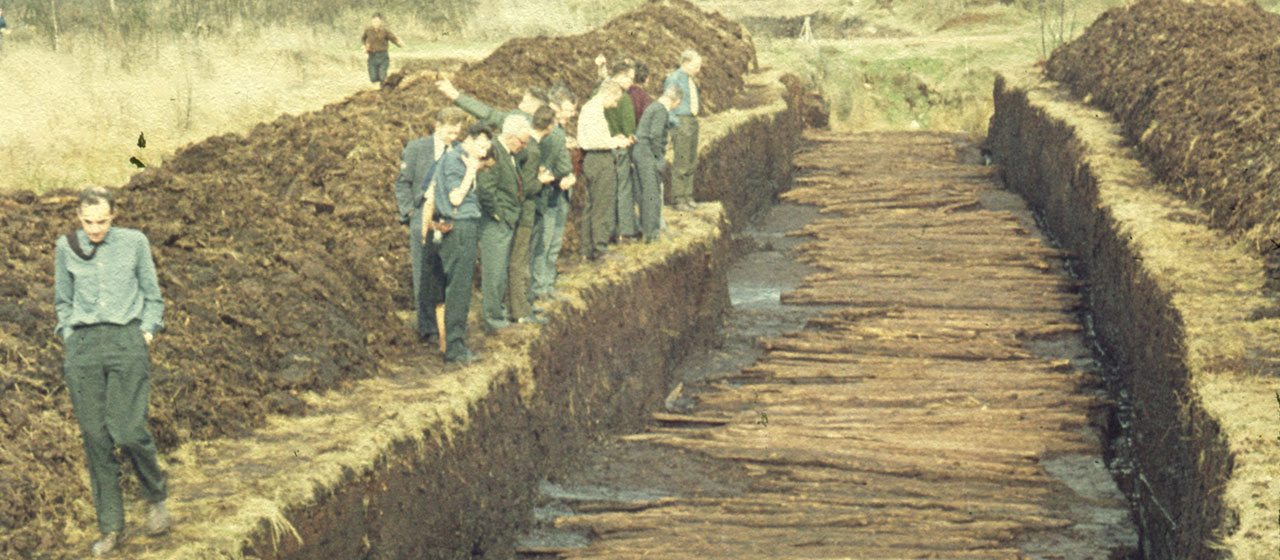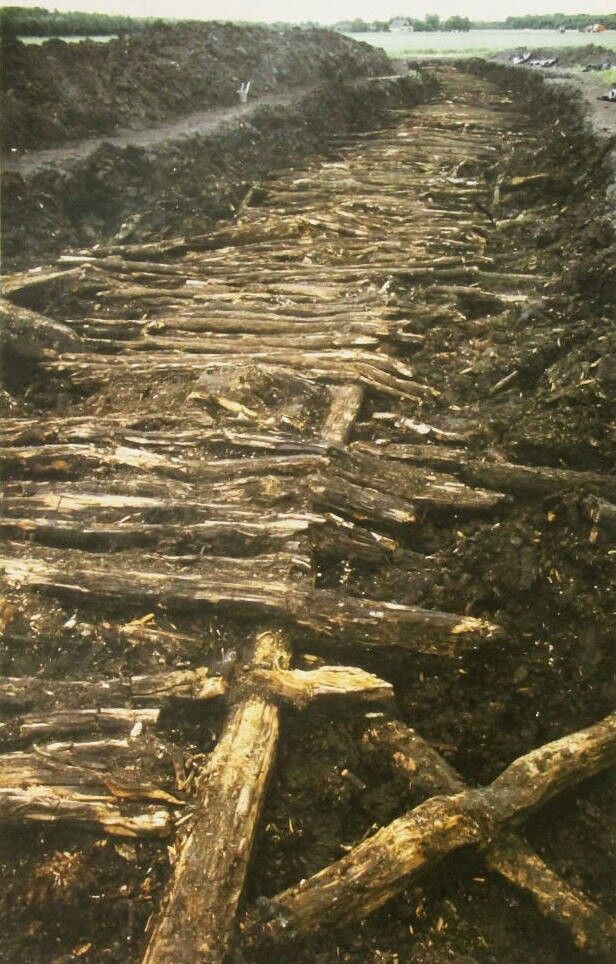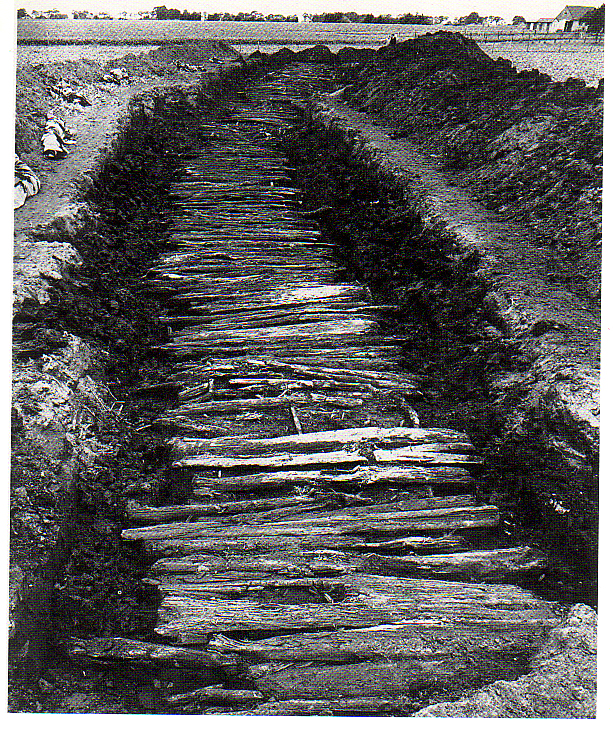Introduction
In the picturesque countryside of the Netherlands, a remarkable discovery has shed light on the sophisticated infrastructure of Neolithic Europe. In the 1980s, archaeologists unearthed an ancient wooden road near the town of Nieuw-Dordrecht, a testament to the engineering prowess of our prehistoric ancestors. This peat road, dating back an impressive 4,573 years, stretches for at least 800 meters and was meticulously constructed in 2,549 BC.

Through the science of dendrochronology, or tree-ring dating, experts have been able to precisely pinpoint the construction of this remarkable structure. This discovery not only highlights the advanced skills of Neolithic communities but also offers a rare glimpse into their transportation and trade practices, providing invaluable insights into the daily lives and interconnectedness of these ancient peoples.
In this blog post, we will delve into the fascinating history and significance of the Nieuw-Dordrecht Neolithic wooden road, exploring the insights it offers into the technological and social advancements of prehistoric Europe.
The Discovery of the Nieuw-Dordrecht Neolithic Wooden Road
The story of the Nieuw-Dordrecht Neolithic wooden road begins in the 1980s, when a team of dedicated archaeologists made a remarkable discovery in the peat bogs of the Netherlands. As they carefully excavated the site, they uncovered a well-preserved wooden structure that stretched for hundreds of meters, defying the passage of time.

Through meticulous analysis, the researchers were able to determine that this was no ordinary wooden structure, but rather an ancient road that had been painstakingly constructed by Neolithic communities over 4,500 years ago. The road’s remarkable state of preservation, thanks to the anaerobic conditions of the peat bogs, allowed the archaeologists to study it in great detail, shedding light on the engineering prowess and transportation practices of these prehistoric people.
Dendrochronology: Unlocking the Secrets of the Wooden Road
One of the key tools used by the researchers to uncover the secrets of the Nieuw-Dordrecht Neolithic wooden road was the science of dendrochronology, or tree-ring dating. By analyzing the growth rings of the wooden planks and beams that made up the road, the archaeologists were able to precisely pinpoint the year of its construction: 2,549 BC.

Dendrochronology is a powerful tool in the field of archaeology, as it allows researchers to establish precise timelines and chronologies for historical structures and artifacts. By carefully studying the patterns of tree growth, dendrochronologists can not only determine the age of a wooden object but also gather valuable information about the climate and environmental conditions that existed at the time of its creation.
In the case of the Nieuw-Dordrecht Neolithic wooden road, the dendrochronological analysis revealed that the road was constructed using a variety of tree species, including oak, alder, and ash. This diversity in the choice of materials suggests that the Neolithic builders were skilled in selecting the most appropriate and durable woods for their construction projects.
Engineering Prowess of Neolithic Communities
The Nieuw-Dordrecht Neolithic wooden road stands as a testament to the advanced engineering skills of prehistoric communities in Europe. The construction of this 800-meter-long road, which would have required the coordinated efforts of many individuals, is a remarkable feat of planning, organization, and technical expertise.
To build the road, the Neolithic builders first had to harvest and prepare the necessary timber, carefully selecting the appropriate trees and cutting them to size. They then used a variety of techniques, including interlocking wooden planks and beams, to create a sturdy and stable structure that could withstand the weight of pedestrians and possibly even light vehicles.

The road’s impressive length and the fact that it was constructed across a peat bog, which can be a challenging and unstable terrain, further highlights the engineering prowess of its builders. They likely employed techniques such as the use of wooden piles or fascines (bundles of sticks) to provide a stable foundation and ensure the road’s longevity.
Moreover, the road’s alignment and the strategic placement of its wooden elements suggest that the Neolithic builders had a keen understanding of engineering principles, such as load distribution and structural integrity. This level of sophistication is a remarkable testament to the technological advancements of these ancient communities, challenging the common misconception that prehistoric societies were primitive and unsophisticated.
Insights into Neolithic Transportation and Trade Practices
The Nieuw-Dordrecht Neolithic wooden road not only showcases the engineering skills of its builders but also provides invaluable insights into the transportation and trade practices of Neolithic Europe. As a well-preserved and extensive transportation network, the road offers a rare glimpse into the daily lives and interconnectedness of these ancient communities.
One of the key insights gleaned from the road’s discovery is the importance of overland transportation and trade in Neolithic Europe. While water-based transportation, such as the use of canoes or rafts, was likely common, the construction of this long and well-engineered road suggests that land-based trade and travel were also crucial to the Neolithic way of life.

The road’s strategic location, connecting various settlements and resource-rich areas, indicates that it was likely used for the movement of goods, people, and ideas across the landscape. This interconnectedness would have facilitated the exchange of resources, the spread of cultural practices, and the dissemination of knowledge, all of which were vital to the prosperity and development of Neolithic societies.
Furthermore, the road’s preservation has allowed archaeologists to study the types of materials and artifacts that may have been transported along its length. Analyses of the soil and sediments found within the road’s structure have revealed the presence of various plant and animal remains, providing clues about the diverse range of resources and commodities that were likely traded and transported by the Neolithic people.
Implications for Understanding Neolithic Society
The discovery of the Nieuw-Dordrecht Neolithic wooden road has far-reaching implications for our understanding of Neolithic society and its level of technological and social sophistication. This remarkable structure challenges the common perception of prehistoric communities as primitive and isolated, instead revealing a complex web of interconnected settlements and trade networks.
One of the most significant implications of this discovery is the insight it provides into the organizational and collaborative skills of Neolithic communities. The construction of an 800-meter-long road would have required the coordinated efforts of many individuals, as well as a high degree of planning, resource management, and division of labor. This suggests that Neolithic societies were not simply collections of small, independent groups, but rather complex social structures with the capacity to undertake large-scale, collaborative projects.

Furthermore, the road’s strategic location and its role in facilitating the movement of goods, people, and ideas across the landscape point to the existence of well-developed trade networks and systems of exchange. This, in turn, suggests that Neolithic communities were not isolated but rather engaged in a broader system of economic and cultural interactions, contributing to the development and dissemination of technological innovations, artistic traditions, and social practices.
The preservation of the Nieuw-Dordrecht Neolithic wooden road has also provided archaeologists with a rare opportunity to study the daily lives and material culture of these ancient people. By analyzing the artifacts and environmental data found within the road’s structure, researchers can gain insights into the Neolithic diet, resource management, and even the social hierarchies and gender roles that existed within these communities.
Conclusion
The discovery of the Nieuw-Dordrecht Neolithic wooden road in the Netherlands has profoundly changed our understanding of prehistoric Europe. This remarkable 4,573-year-old structure, meticulously dated through the science of dendrochronology, stands as a testament to the advanced engineering skills and sophisticated transportation and trade practices of Neolithic communities.
Through the preservation of this ancient road, we have been granted a rare glimpse into the daily lives, social structures, and interconnectedness of these prehistoric peoples. The road’s strategic location, construction techniques, and the diverse range of materials and artifacts found along its length all contribute to a deeper understanding of the technological and cultural advancements of Neolithic Europe.
As we continue to explore and study the Nieuw-Dordrecht Neolithic wooden road, we can expect to uncover even more insights into the rich and complex history of our prehistoric ancestors. This remarkable discovery serves as a powerful reminder that the past is not a distant, forgotten realm, but rather a vital part of our shared human story – a story that is still unfolding, with each new archaeological find shedding light on the remarkable ingenuity and resilience of our forebears.

